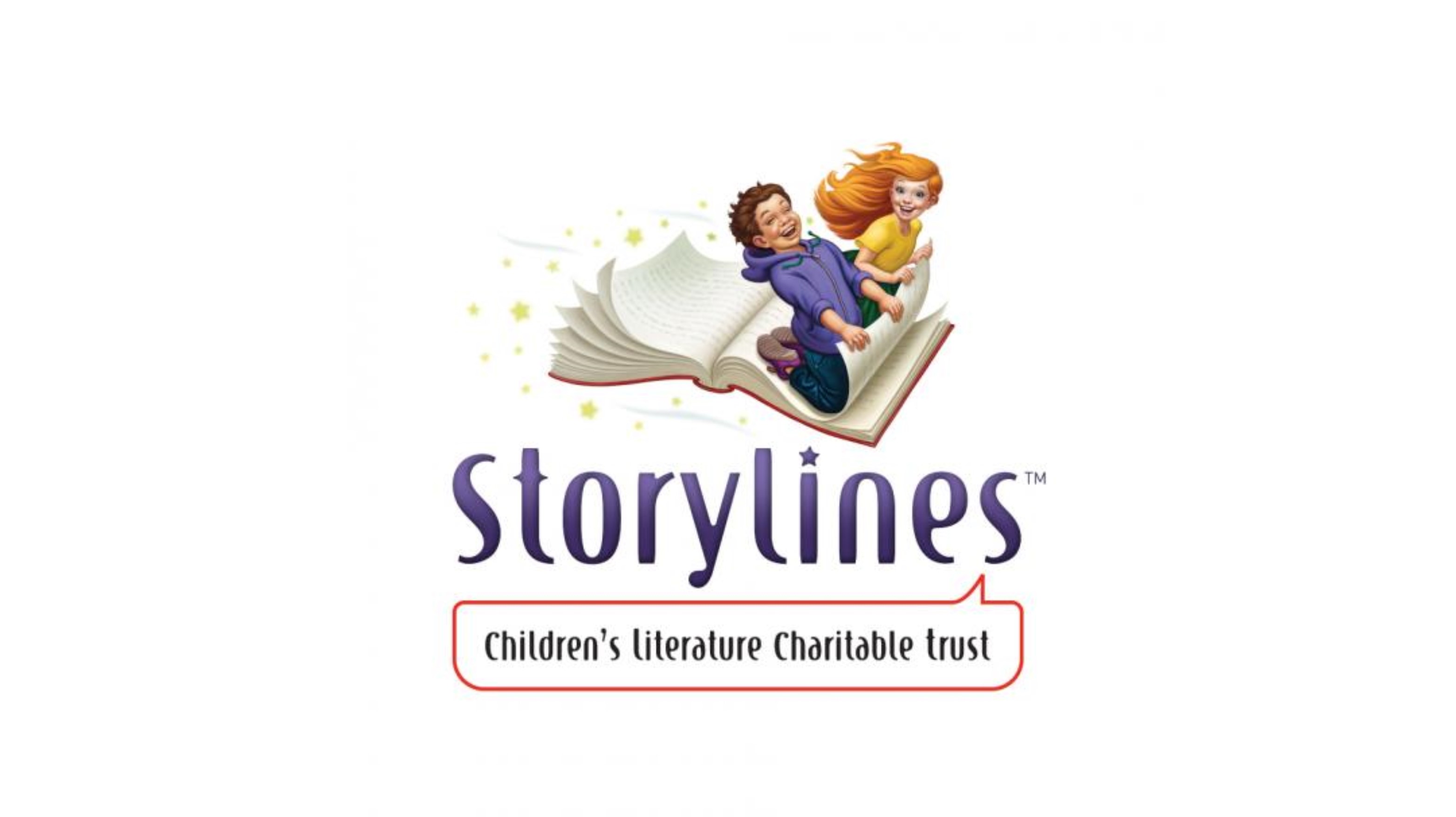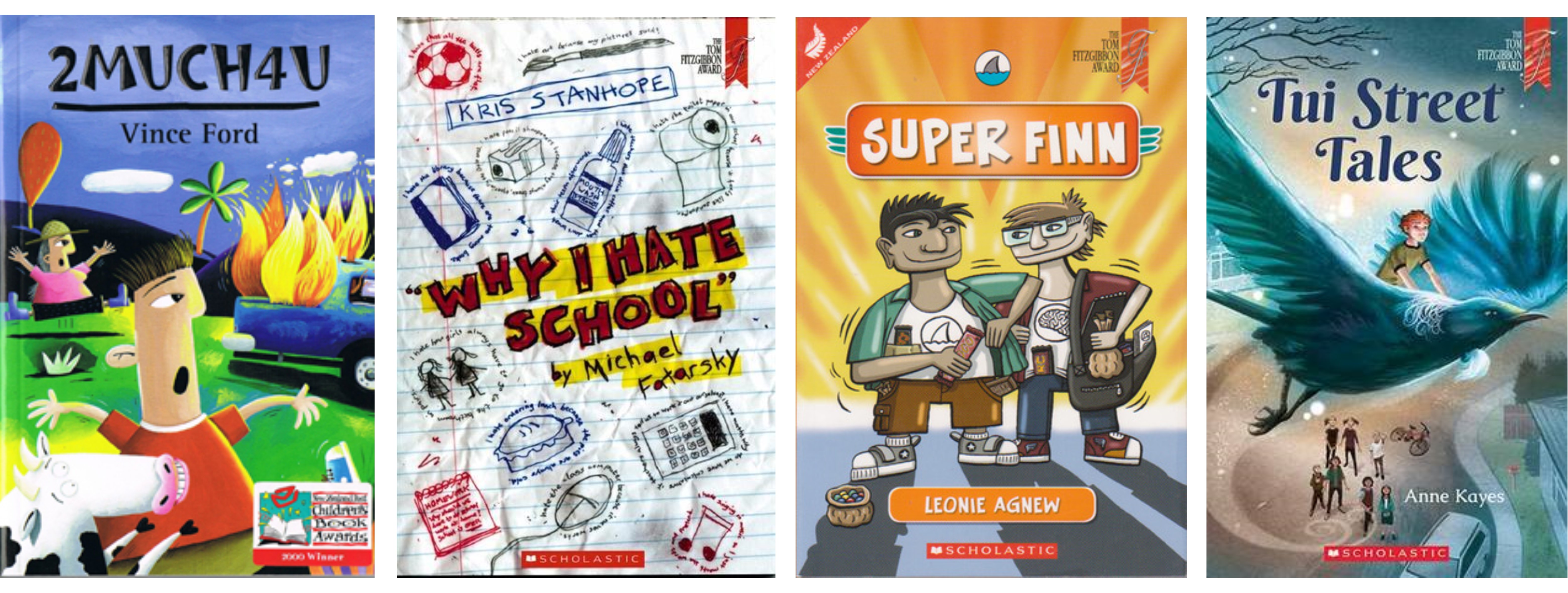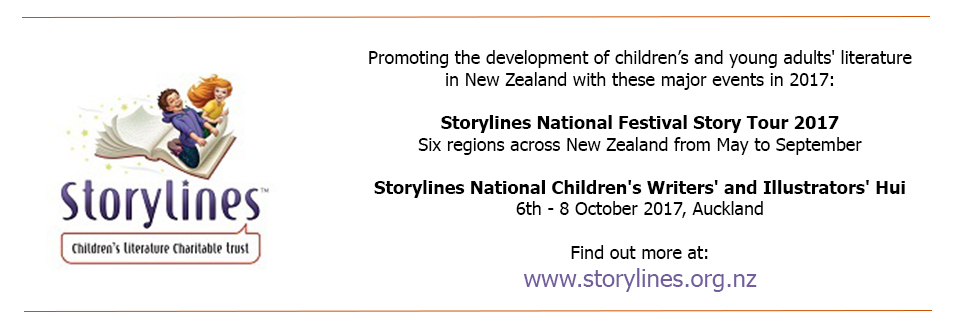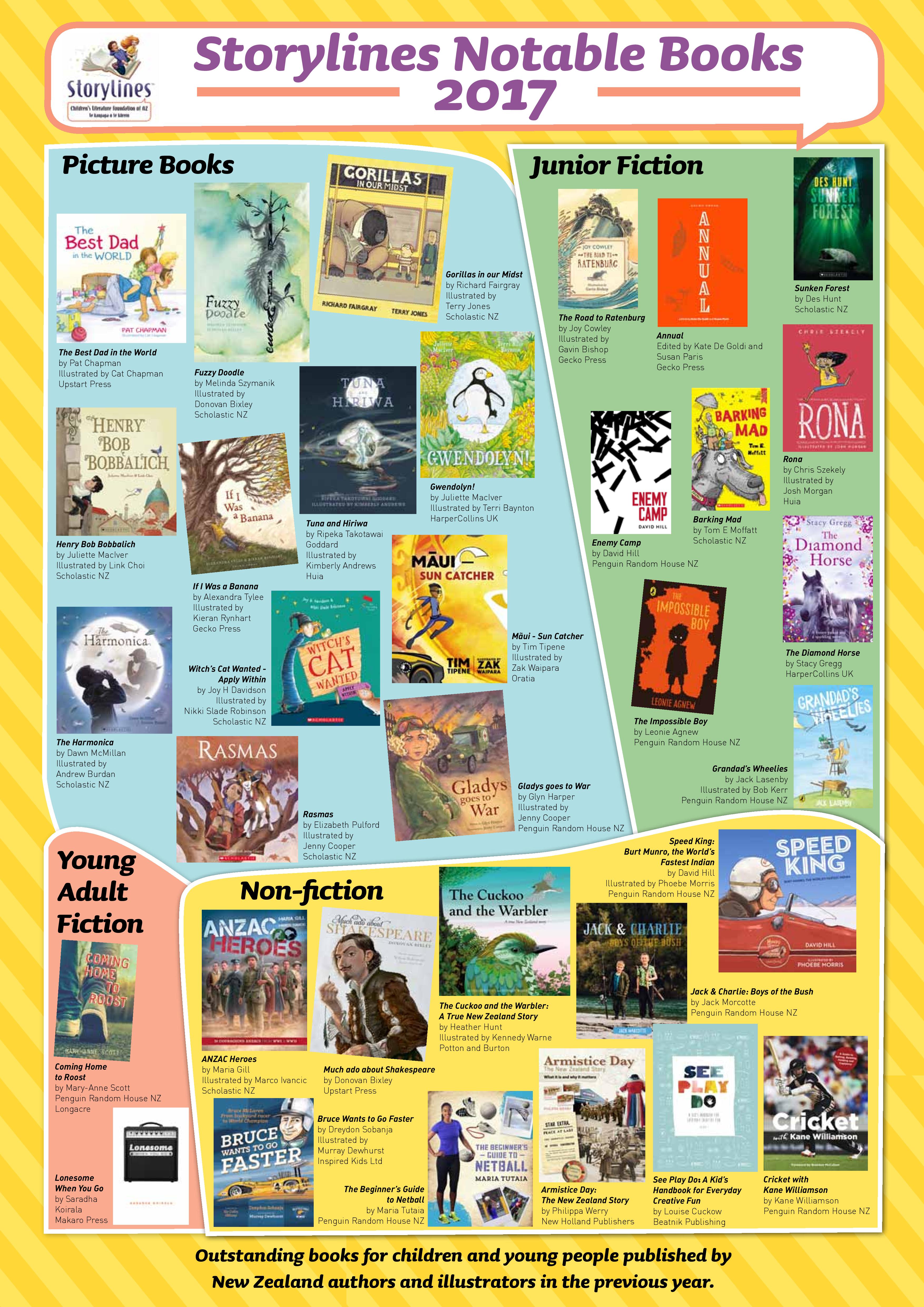Storylines Children’s Literature Charitable Trust continues to play a significant part in boosting the children’s literature culture here in New Zealand. We asked Tessa Duder, beloved author and Storylines Trustee, to tell us how the Storylines Awards came about.

When the organisation that grew into today’s Storylines first set up shop in 1991, among its first aims were to bolster the number and type of awards open to New Zealand children’s writers and illustrators.
The 1980s had been an exciting ride. Maurice Gee had kicked it off in 1979 with Under the Mountain, and Gavin Bishop with Mrs McGinty and the Bizarre Plant. Margaret Mahy and Joy Cowley were winning plaudits offshore, and the Government Publishing Awards had, from 1981 until 1988, become low-key additions to the country’s literary calendar. Very junior cousins to the adult book awards, but still…
Up until this point, the only awards that existed were LIANZA’s Esther Glen Award, begun in the 1940s for writing, plus the Russell Clark Prize for illustration, but the few authors who were being published (besides Cowley and Mahy, Anne de Roo, Ron Bacon, Phyllis Johnston, Ruth Dallas, Joan de Hamel) were going offshore or making up a miniscule local list.
Light blue touch paper…
Come the 1980s, a flame had been lit. The AIM awards carried the torch for eight years, then New Zealand Post took over and in 2014, the Book Awards Trust. Prestige, profile and prize money increased, as did the numbers of entrants and, therefore, the competition. But until 1991, all of these awards were for the best of published books. There were no awards for ‘lifetime achievement’ or ‘outstanding contribution’, or for manuscripts to discover new writers. From the Arts Council/Creative New Zealand, there were small annual grants for the works-in-progress of a handful of writers and illustrators, but little else of practical encouragement.
So Storylines’ first move was to establish the annual Storylines Margaret Mahy Medal and Lecture Award, presented for lifetime achievement and an outstanding contribution to the genre. It is rightly known as New Zealand’s ‘most prestigious’ award in children’s literature. Margaret’s first marvellous presentation in 1991 has inspired lectures by a stellar list of authors, illustrators and three publishers. Interestingly, a significant number of Mahy medallists have also been awarded high civil honours, honorary doctorates and Arts Foundation Laureates.
Margaret’s first marvellous presentation in 1991 has inspired lectures by a stellar list of authors, illustrators and three publishers.
The annual Storylines Betty Gilderdale Award began as the Auckland-based Children’s Literature Association’s service award. Since 1990 it has honoured a varied group of ‘unsung heroes’: agents, publishers, academics, reviewers, booksellers. The lectures presented by the winners of both the Mahy and Gilderdale awards are published online, providing a growing body of valuable commentary.
In 1996, with Storylines having set up its annual Festival of New Zealand Children’s Writers and Illustrators, the Storylines Tom Fitzgibbon Award was announced, in partnership with Scholastic New Zealand. Given for a junior novel manuscript by an unpublished author, the award attracts an average of 25–30 manuscripts each year and has kick-started some solid careers, such as those of Vince Ford and Leonie Agnew. This year’s winner, Christine Walker, with The Short but Brilliant Career of Lucas Weed, hails from Christchurch.

Next up was the Storylines Gaelyn Gordon Award for a Much-Loved Book, commemorating Gaelyn Gordon after her untimely death in 1997. Her three publishers, HarperCollins, Scholastic and David Ling, contributed to an establishment fund, agreeing that as ‘the best Kiwi author whose books never quite won a major award’, Gaelyn would be best remembered by recognising books which had similarly missed out, but had proved themselves popular over time with young readers. Unsurprisingly, the books honoured since 1999 have included famous names like Elsie Locke, Pamela Allen and Fleur Beale (twice), David Hill, Jack Lasenby, Lynley Dodd and Maurice Gee.
Scholastic came to the party again in 2003, when the Storylines Joy Cowley Award for a picture book text was established, open to all New Zealand-resident writers, published or not. Close to 200 entries are usually received and, as with the Fitzgibbon award, some exciting talents like Kyle Mewburn revealed. Until recently, Joy was involved in the selection and editing of the winning manuscript. On a few occasions – including this year – both these awards’ judges have had to make the tough decision, always with regret, that no shortlisted manuscript met Scholastic’s publication standard.

And two new awards
Fast forward to 2010 when two new awards were on offer. The Storylines Tessa Duder Award, initially in partnership with HarperCollins New Zealand, was established to find exciting new Young Adult novelists, though it is now open to all Kiwi-based authors (published or not). Around 15–20 submissions are generally received in each award round. Though two awards were initially made (in 2011 and 2012), none followed until 2016 when new sponsor Walker Books Australia came on board. Gareth Ward’s steampunk adventure The Traitor and the Thief is due for publication by Walker in August 2017.
Also in 2010, the biennial Storylines Gavin Bishop Award for Illustration submitted by an unpublished illustrator was first presented, supported by Random House. As well as a monetary prize, the winning illustrator receives mentorship from Gavin Bishop. Two further awards have been made, in 2013 and, now with Penguin Random House, in 2017. Gavin has described the 2017 winner, Feilding teenager Lael Chisholm, chosen from a field of 18, as a young artist with a very bright future.
Changes in definitions
Over time, guidelines and criteria for the Storylines manuscript awards have inevitably evolved. The definition of ‘unpublished’ has changed, with eligibility criteria relaxed to allow entrants to have been previously published in school readers, anthologies and other short formats.
The Storylines Notable Books listings are now in their eighteenth year and gathering prestige as each year passes. Anecdotal evidence attests to publishers, authors and illustrators being equally, if not more, gratified by a Storylines Notable Book listing as by a shortlisting in other awards.
The ‘Notables’ were set up in 1999, to reflect Storylines’ growing belief that, in the absence of a ‘long list’ provided by our country’s major book awards (as enjoyed in Australia), many more than twenty excellent children’s books were now being published in any one year. With the AIM and NZ Post awards’ narrow focus on only five books being shortlisted in four categories, Storylines believed that children, families, schools and libraries were not being made fully aware of the increasing volume, appeal and diversity of New Zealand children’s publishing.
Storylines believed that children, families, schools and libraries were not being made fully aware of the increasing volume, appeal and diversity of New Zealand children’s publishing.
Thus in 1999, the Storylines Notable Books, up to ten books in each category: Junior Fiction, Young Adult, Non-fiction and Picture Books. The judging panels, one for each genre, spend many hours of their winter and summer holidays assessing the books submitted during the year and attending regular meetings, with lists finalised by mid-February.
There’s some leeway for the panels to add one or two books if the standard is unusually high (this year there are 12 Picture Books named), or to award fewer Notable Book Awards than allowed. The 2017 list features only two Young Adult novels – but only six were submitted, and none by acknowledged leaders in the genre. The two previous years had not been much better, with just five, then four deemed worthy. It would seem that the publishing upheavals of a few years ago have seen a reduced commitment to writing targeted at young adults, with publishers cutting back and writers discouraged.

The remarkable rise of self-publishing has been reflected in Storylines Notable Books. The 2016 list saw a good number included, though there are noticeably fewer in 2017. This year the mainstream publishers like Penguin Random House and Scholastic dominate, but lively independent publishers like Gecko, Potton & Burton, Upstart Press, Duck Creek and Huia Publishing are represented too. It needs to be strongly emphasised here that all submissions, whether self-published or from ‘indie’ or mainstream publishers, are judged by exactly the same criteria.
Raising the profile
While Storylines is proud of its eight awards, challenges remain.
It is not difficult for Storylines to find qualified volunteers to commit to administration and judging, far from it. Restraints are imposed more by a general lack of funding for promotion, and a media generally indifferent to arts stories unless they involve ‘celebrities’ or lots of money. Only in the last two years has Storylines been able to hire a professional publicist, and create a colourful Notable Books poster for schools, libraries and booksellers to download. (See Storylines website).
Every year Storylines affirms its belief in its awards’ short and long-term benefits, and the value of providing stimulus for writers and illustrators. Over three decades, tens of authors have experienced the encouragement of being shortlisted or the joy of winning, and hundreds of deserving books have been recognised as ‘Notable.’
Ultimately, young readers benefit.
That, in itself, is reward enough for Storylines’ small army of children’s book enthusiasts whose pro bono time and professional skills given freely each year make the Storylines awards happen.

Tessa Duder
Tessa Duder, writer, editor, creative writing teacher, was a founding member of the Storylines Children’s Literature Trust (2005) and its forerunner the Children’s Book Foundation (1991). Since her first book Night Race to Kawau in 1982, she has published nearly 50 books of fiction and non-fiction for both children and adults, including 11 anthologies and the multi award-winning AlexQuartet.
Her awards include a number of children’s fiction prizes, the Storylines Margaret Mahy Medal and Gaelyn Gordon Award for a Much-Loved book, the Katherine Mansfield Fellowship, an Artists to Antarctica award, the OBE (1994) and an Honorary Doctorate from the University of Waikato. She has four daughters and two grandchildren and lives in Auckland.



